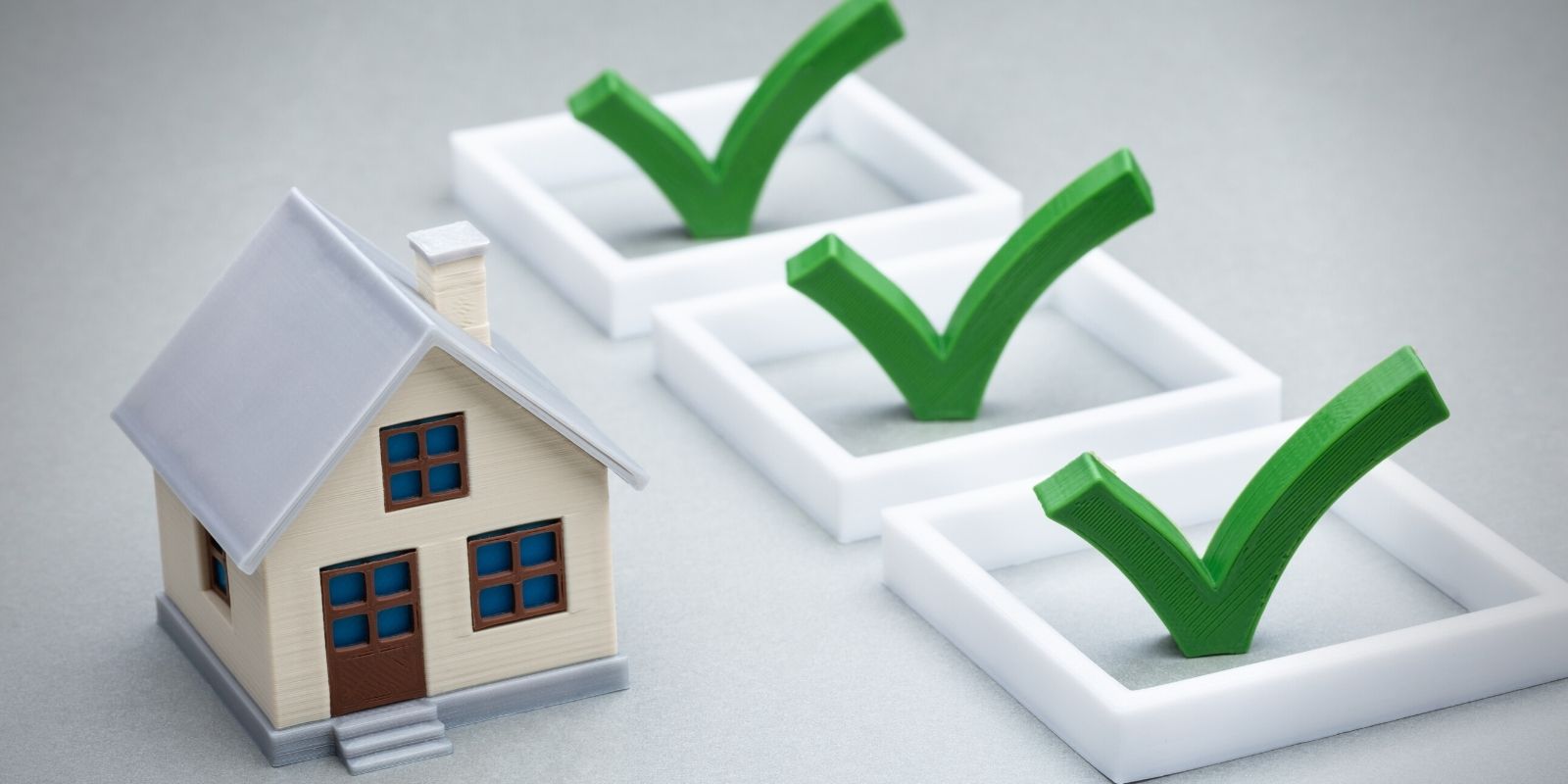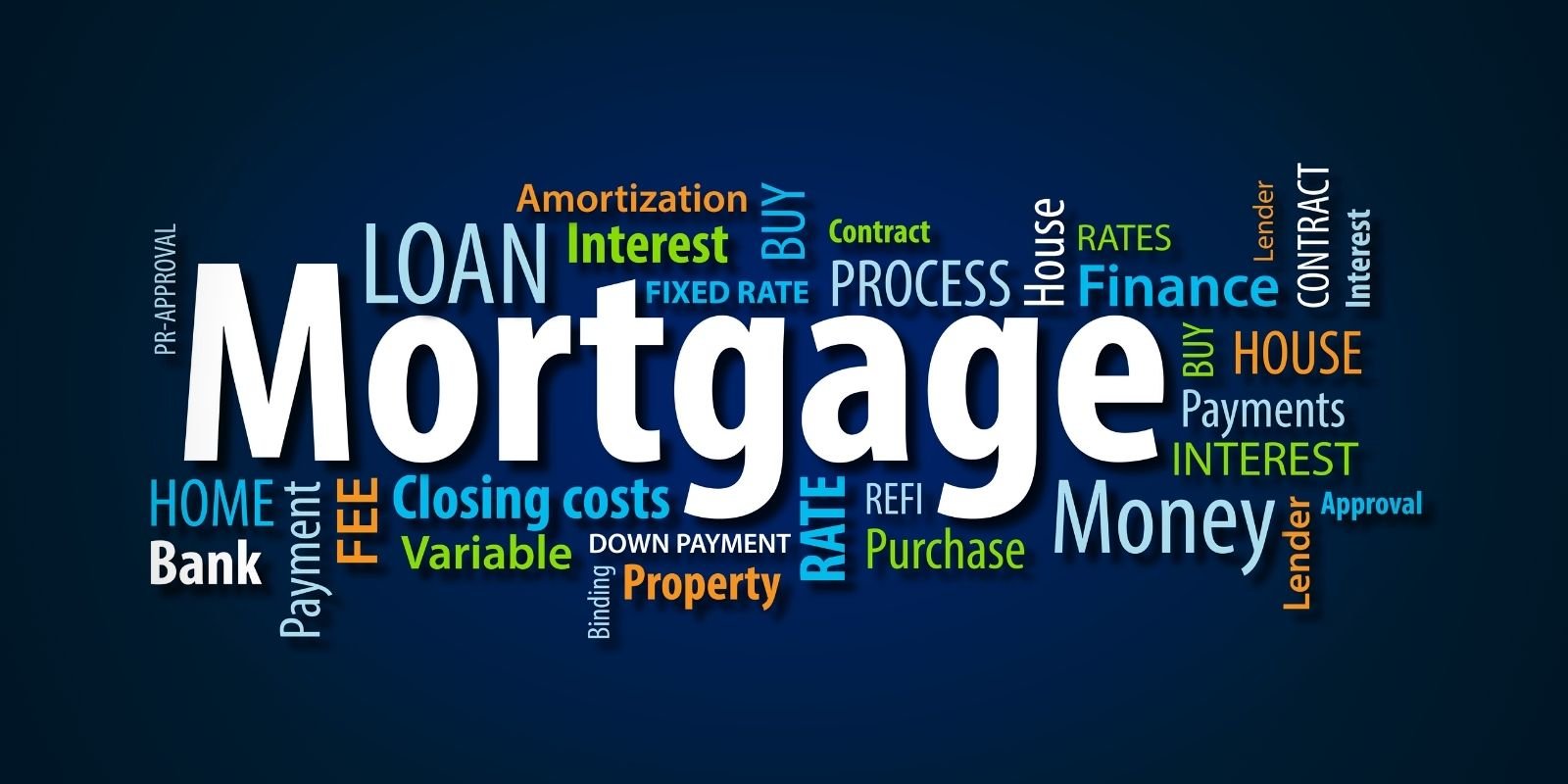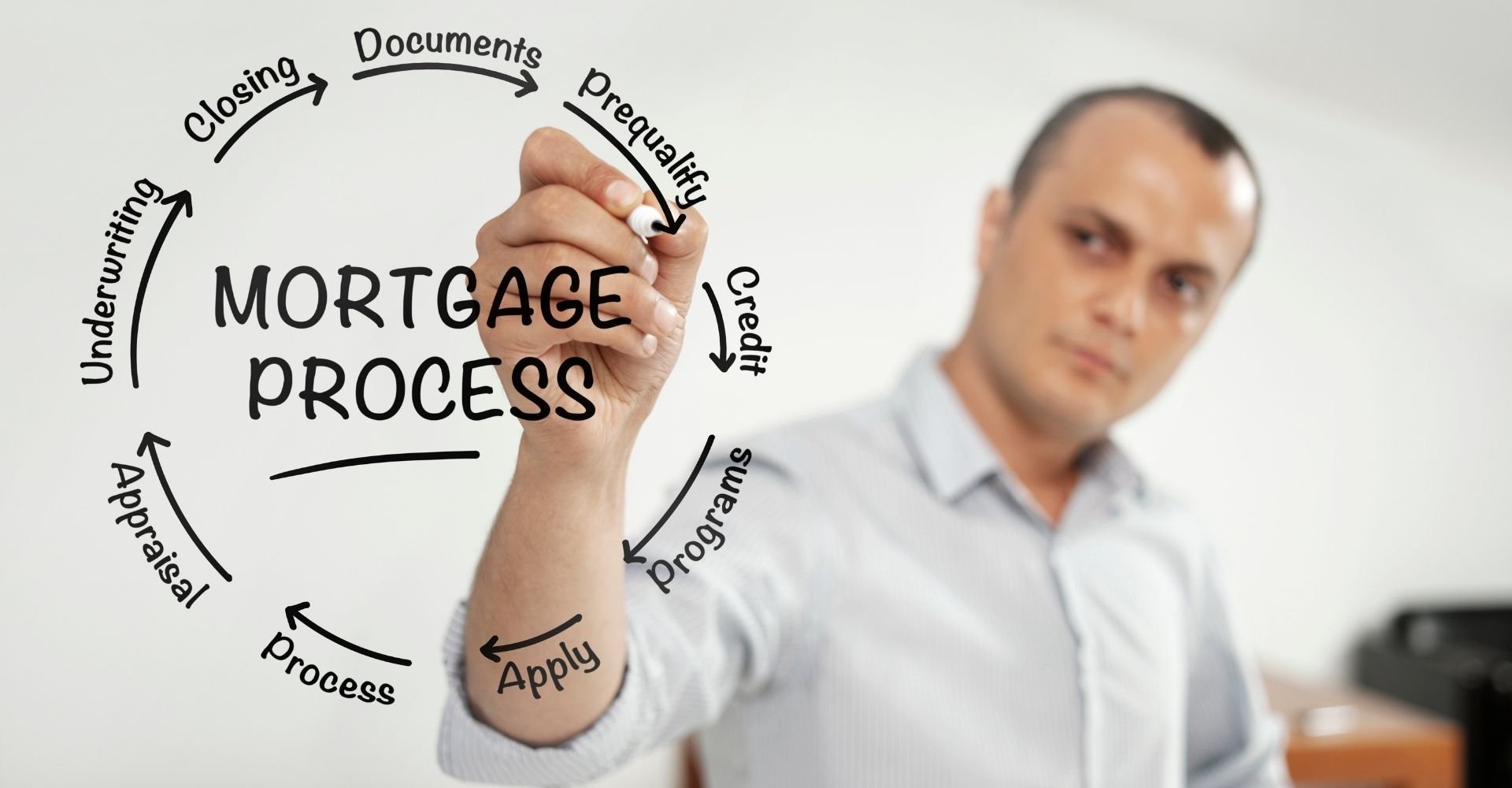The mortgage loan process looks mysterious from the outside.
You give a lender a tall stack of financial documents and personal information, which then descend into a bureaucratic black hole until you show up on closing day and get the keys to a new house.
Who knows what happens in between.
If you’re wondering what really happens during the process of applying for, issuing, and closing on a mortgage loan, we’ve created this step-by-step guide on who does what during the mortgage loan process, as well as what to expect as a homebuyer.

Pre-Home Shopping Steps
Jumping the gun and looking for houses right away will likely lead to disappointment, as you may not qualify for a mortgage or you may not be able to get pre-approved quickly enough to close.
Save yourself a headache and some disappointment by following these steps before you start going to open houses.
1. Choose A Lender
If you have a preexisting relationship with a bank or credit union, ask them what types of mortgage products they offer.
You may get favorable terms because they already know you and for financial history.
However, don’t assume your local bank has the best terms on mortgages.
A tenth of a percent difference in your interest rate can translate to thousands of dollars over the life of your loan, so it’s worth your while to shop around to find the best terms.
If you need a little more guidance, we published a guide for homebuyers about finding a mortgage lender.
2. Loan Types
If this is your first time purchasing a home, you may not realize that there are multiple types of mortgages.
Each has different qualifications, interest rates, down payment requirements, and so on.
Here’s a rundown on some of the most common types of mortgages.
Ask your lender which type they recommend for you.
Conventional Mortgages
A conventional mortgage (a.k.a. a traditional mortgage) is a private contract between you and the lender.
It is not subsidized or backed by the government.
Down payments on conventional loans are usually around 20%, as the lender wants to make sure you have a decent chunk of equity in the house so you don’t stop making your payments.
Since the bank is the only one calling the shots, conventional loans allow for more flexibility on terms, interest rates, and property types than other mortgage types.
Pros of Conventional Mortgages
- More options. Traditional mortgages can be used for your primary residence or a vacation home or rental property.
- Better PMI. If your lender allows you to put down less than 20%, private mortgage insurance (PMI) on traditional mortgages is 0.5 – 1% of the loan amount per year. This is less than other mortgage types (such as FHA).
- Less government red tape. With government-backed loans, homes must meet strict guidelines for the value and condition of the home. Conventional mortgages are much more accommodating and flexible.
- Customizable terms. Don’t fancy making payments for 30 years? Conventional loans can be amortized over 10, 20, or 30 years, as long as your lender allows it.
Cons of Conventional Mortgages
- Higher credit score needed. Banks typically require borrowers to have at least a 620 credit score for conventional loans, though they can up that number. Borrowers with scores above 740 get the best interest rates.
- Big down payment. Not all homebuyers (especially first-time buyers) can come up with a 20% down payment for a mortgage.
FHA Mortgages
The Federal Housing Administration (FHA) backs loans to people with lower credit scores and allows for smaller down payments than conventional loans do.
The FHA loan program enables people of modest means who otherwise wouldn’t be able to qualify for a traditional mortgage to be able to purchase a home and enjoy the benefits of homeownership.
The favorable terms and easy qualifications of FHA loans make them a popular choice for many homebuyers.
Pros of FHA Mortgages
- Minimal down payment. FHA loans require only 3.5% down for most buyers. That number goes up to 10% if your credit score is between 500 and 579.
- Alternative down payment options. With FHA loans, you can use a gift from a relative as a down payment. FHA loans also offer down payment assistance in some cases.
- Low credit score requirements. If your FICO score is above 500 you can qualify for an FHA loan.
Cons of FHA Mortgages
- Less flexible terms. A 15-year mortgage and a 30-year mortgage are your only options. You cannot adjust the amortization schedule to suit your needs.
- Property standards. You cannot use an FHA loan to purchase a fixer-upper home. Only homes that meet the U.S. Housing and Urban Development (HUD) standards qualify for an FHA mortgage. Things like peeling paint, a cracked window, or worn-out countertops must be fixed before the home meets the requirements for an FHA loan.
- Work history. FHA lenders rely on your work history in addition to your credit score when making lending decisions. This is great if you have a steady, full-time job, but problematic if you’ve changed jobs, lost your job, or get sporadic income. FHA lenders typically require two years of steady income, preferably from the same job.
- Price ceilings. In most areas, FHA loans can only be issued for up to $420,680 (in high-cost areas, this limit bumps up to $970,800).
- Owner occupancy requirement. FHA loans are only for primary residences, not investment properties. However, if you want to purchase a home with up to four units and live in one of them, you can do this with an FHA loan.
- PMI. The PMI requirements for FHA loans are relatively high compared to other mortgage types. On an FHA loan, you must pay an upfront mortgage premium, which is 1.75% of the loan amount and an annual payment of 0.8% to 1.05% of the remaining loan balance. Also, you can’t get rid of the PMI on your FHA loan unless you pay it off or refinance.
VA Loans
VA loans are mortgage loans designed for military service members, veterans, or their spouses.
They come with multiple unique benefits and are a useful tool for those that qualify.
You can find a complete list of requirements at the Department of Veterans’ Affairs website, but to begin a conversation with your lender, have your duty or discharge status with a Certificate of Eligibility (COE) ready.
VA loans are also backed by the government, so banks will issue VA loans to borrowers with less-than-stellar credit and smaller down payments.
Pros of VA Mortgages
- No down payment. VA loans are some of the only mortgages with a 0% down payment requirement. Be aware that you will be responsible for certain other fees though.
- Rock-bottom interest rates. The interest rates on VA loans are often lower than most other mortgage types.
- No PMI. VA loans have no PMI requirements, so this can be huge cost savings for borrowers with less than a 20% down payment.
- Permissive DTI ratio requirements. VA loans are available to borrowers with a DTI ratio—50% for adjustable-rate mortgages and 60% for fixed-rate mortgages. So even if you have other debts, you may still qualify for a VA loan.
- 100% loan-to-value allowance. VA loans are some of the only mortgages that allow you to borrow the full purchase price of the property. You can sometimes qualify for even more if the house needs improvements. This is also true for cash-out refinances —you can cash out 100% of the equity you have in the property if you use a VA loan.
Cons of VA Mortgages
- Only for qualified veterans/spouses. The VA has very specific requirements for military members or their spouses to qualify for VA loans (length of service, honorable discharge, etc.). Check here to see if you qualify.
- Funding fee. Though you might not need a down payment, VA loans do require a one-time 1.4% – 3.6% funding fee. This fee offsets the cost of the VA loan program to taxpayers. (Lucky for the borrower, this substantial fee can be rolled into the loan and paid for over time.)
- Potential to end up “underwater.” While it may seem advantageous to borrow 100% of a home’s value, a drop in real estate property values (even a small one) can put VA borrowers “under water” quickly. In this situation, the borrower owes more on their mortgage than the home is worth.
USDA Loans
USDA loans are for homebuyers in designated rural areas.
To qualify for a USDA loan, you must try (and fail) to get a mortgage from a traditional bank or lender.
Your income also must stay under a certain limit, which is adjusted for the cost of living in your area.
Pros of USDA Mortgages
- No down payment. Just like VA loans, USDA loans require no down payment. Also, you can borrow the entire value of the property, as well as some extra cash for closing costs and repairs.
- New construction. If you want to build your own home, a USDA loan can cover the cost of the lot, the construction, and the financing to do so.
- No cash reserves required. Some lenders require you to have enough savings in the bank to cover a few months of loan payments, but this is not the case with USDA loans.
Cons of USDA Mortgages
- Only good for rural properties. To qualify for a USDA loan, your property must be located in a designated rural area. You may not be stuck with a cabin in the boonies, though. The USDA-approved areas include small towns, as well as areas just outside major metropolises. The USDA website will help you see whether a location meets the geographic guidelines for a USDA loan.
- Square footage limits. You may only get a USDA loan for a house that is 2,000 square feet or less. If you’re close to this limit, check with your lender; you may still be able to qualify.
- Inflexible terms. USDA loans are only available in 30-year terms.
- Income limits. If you make more income than the income guidelines allow for your area, you will not qualify for a USDA mortgage. The limit is typically 115% of the median income for your region.
3. Mortgage Pre-Approval
With the cutthroat real estate market today, you’ll need a pre-approval letter to compete with other offers.
This is a note from the bank stating that they’ve reviewed your finances in detail and they’re willing to lend you a mortgage up to a stated amount. (Don’t confuse pre-qualification with pre-approval, as the former is much less detailed and carries less clout than the latter.)
To get pre-approval from a lender, you’ll need to supply them with the following paperwork:
- Driver license
- Social Security card
- Pay stubs from the last 30 days
- W-2s from the last two years
- Personal federal tax returns from the last two years
- Bank statements from the last two months of all financial accounts: checking, savings, IRA, 401(k), and brokerage. Statements must show your name, account number, and the name of your bank.
- If someone in your family is giving you money to help pay for the house, you’ll need a gift letter signed and dated by the person helping you.
- Any freelance or business tax returns from the last two years
- If you’re retired, you’ll need your benefit verification letter, your last two years of 1099 forms, and tax returns
Regardless of the amount the bank pre-approves you for, stick to your home buying budget.
The pre-approval amount is generated from statistics and formulas and does not take into account your personal financial needs or situation.
You are the one making monthly payments, not the bank, so don’t go over budget — even if your pre-approval letter allows for a higher price than you’d planned on.
Trying to buy a more expensive home than you can afford is a common mistake home buyers make when shopping for a mortgage.
4. Shop for a House
Shopping for a house can be extremely exciting — and stressful.
Enjoy the journey, but don’t get caught up in the process.
Unless you’re buying a newly constructed home, not everything about it will be perfect.
Make a list of the most important things, as well as the nice-to-have items.
If it’s your first home, you’ll want to avoid the most common first-time homebuyer mistakes.
Once you’ve found “the one,” you’ll put in an offer to the seller to buy the home (don’t forget to attach your preapproval letter).
The seller may accept your offer as is, or you may go back and forth to negotiate terms (such as inspection contingencies, who pays for closing costs, or repairs prior to closing) to make the deal more acceptable for either party.
When you and the seller come to an agreement, you make a purchase agreement, which is a contract to buy the home for a set price.
Typically you’ll give the seller’s escrow agent or title company some earnest money once the contract is signed.
This assures the seller that you’re a serious buyer as they get to keep the money if you back out of the deal (except for those noted as contingencies in the contract).
Earnest money counts toward the final price of the home at closing.

Steps Once You’re Under Contract
The mortgage loan process doesn’t begin until you’ve made an offer on a home and the seller has accepted it.
After that, the following steps will occur.
5. Full Loan Application
Your pre-approval letter was just the beginning.
Most of the documents required for the loan application are the same ones you submitted for pre-approval, but the bank may need some additional information from you as they help you fill out the full loan application.
You’ll need a signed copy of your offer letter, for starters.
Just because you got pre-approved with one lender doesn’t mean you’re locked into taking out a mortgage with them.
In fact, it’s wise to apply with at least three lenders to make sure you’re getting the best rate and terms.
If you’re lucky, you may get the lenders to bid against each other for your business.
Each lender will give you a Loan Estimate document so you can compare each loan apples-to-apples.
Pay special attention to the APR, total cost in five years, principal paid in five years, and percent paid in interest.
6. Order Home Inspection
Before you close the deal, you’ll want to order a home inspection (whether or not your bank requires you to do so).
The inspector will check all the major parts and systems of the house, including the HVAC, roof, electricity, and more.
If the home has any flaws or needs any repairs, the inspector will note them on the report he or she gives you.
This can be a helpful bargaining tool in negotiating the home’s selling price.
7. Loan Processing
Processing is all the work the lender does on the back end to verify the documents you send them.
They will check all of your tax returns, verify your employment, and so on.
They check for veracity as well as regulatory compliance.
8. Homeowners Insurance
If you have a mortgage on the property, you’ll need to have homeowner’s insurance.
Since both you and the bank will have a stake in the property until the loan is paid off, the insurance guarantees that both of you will get reimbursed in case a disaster strikes the home.
9. Appraisal
The bank will also order an appraisal to determine the current market value of the property to make sure it is in line with the price you agreed to in your offer.
This assures them that you’re not paying too much for the property.
The appraiser will measure and factor in the dimensions of your home, as well as its age, condition, location, amenities, features, and needed repairs.
We put together a list of the top 15 factors that can hurt your home appraisal.
After accounting for all these things, the appraiser comes up with a figure of what the home is worth.
The process usually takes about one or two weeks between the time the appraisal is ordered and the time you and the bank get the report.
Even though it’s the bank that wants the appraisal, the homebuyer gets to pay for it as a part of closing costs.
A typical, single-family home appraisal will cost around $300 – $450, though this number will be higher for large homes or expensive markets.
10. Underwriting
Underwriting is the bank’s final stage of research before you close on your loan.
Truth be told, much of this final check is done by bots these days.
Any abnormalities will be flagged and sent to a human underwriter to look into.
Depending on the complexity of your loan and finances, underwriting can take a few days to a few weeks.
To simplify and expedite the process for your lender, don’t sell any property, open any new accounts or take on any new debt until after your mortgage is closed.
11. Closing
The final signing of documents by you, the seller, the bank (and sometimes an attorney) is called the closing or the closing process.
You’ll have to sign a large stack of forms, including the closing disclosure form, settlement statements, promissory note, deed, title insurance documents, and more.
While it can be tempting to just sign on the dotted line and get the process over with, these are legally binding documents with huge implications.
Don’t be shy about asking your lender any questions you have, and don’t sign anything until you understand what it means.
You’ll need to bring your photo ID, a signed closing disclosure form (which you should get 3 days prior to closing), a cashier’s check for the down payment, proof of homeowner’s insurance, and your attorney or real estate agent, if you want to or your state requires it.

Pro Tips During the Home Mortgage Loan Process
While a lot of the mortgage process for you as a homebuyer is sitting around and waiting, there are a few things you can do to speed up (or at least not slow down) the loan process.
Don’t Take on New Debt
If you’re tempted to finance new furniture for your home or a car to put in the driveway, wait until your mortgage closes to avoid delays.
Your lender bases their decision to lend to you on your debt-to-income ratio and credit score, and taking out a new credit card or opening a new credit account of any kind can alter the stats they based their initial decision on.
While this might not mean that you lose the mortgage, it will definitely slow down the mortgage process as underwriters must verify all the new information and how the new debt alters your financial picture.
Lock-In Your Rate
Once the loan is initially approved, you usually have the option to lock in your interest rate, which ensures it won’t change as long as the loan closes in a timely manner.
This can be advantageous: you’re assured that even if interest rates go up, you still get the same rate, and you have a clear picture about how much your monthly payment will be.
However, you do risk losing out if interest rates go down after you lock in your rate.
Your lender may or may not charge a fee to lock in your interest rate, so ask about this before you choose to do so.
Know Your Closing Costs
Every loan will come with fees beyond the principle, interest, insurance, and down payment.
Closing a loan involves a whole lot of people: the county clerk records the deed, the attorney reviews or drafts loan documents, the underwriters verify financial information, the title company creates the title policy, and so on.
Each of these people need to get paid for the services they provide in conjunction with the mortgage, and all those costs can add up.
Expect to pay between 3-6% of the purchase price of the property in these extra closing costs.
Some lenders allow you to roll closing costs into the loan, so you may not have to pay them out of pocket on closing day.
If you opt for this, however, it will mean a slightly higher monthly loan payment.
Perform Final Walkthrough
Before you sign on the dotted line, be sure to do one last walkthrough of the house to ensure that no damage has occurred between the time you made your offer and the closing date.
You’ll want to do this a day or two before closing.
A final walkthrough is especially important if the seller agreed to make repairs before the sale.
You’ll want to make sure they were done properly.
It’s also worth checking that the seller has removed all their property from the home and hasn’t removed anything ( like appliances or fixtures) from the home.

Wrapping up our Step-By-Step Guide to the Mortgage Loan Process
The mortgage loan process can be a lengthy one fraught with long periods of waiting.
However, knowing what’s going on during each of the steps, as well as what you can do to move things along, makes the waiting a little easier.
Most mortgages take between 45 to 60 days to close, so by the time you pack up, reroute your mail, and get all your moving affairs in order, you should be ready to close on the mortgage for your new home!
Whether you’re a buyer or a seller, the mortgage process is made much easier with a trustworthy, experienced real estate agent by your side.
The agents at Helen Painter Group Realtors have been in the real estate business since 1958.
They can direct you to the best lenders in the Fort Worth area and answer any questions you have about the mortgage loan or homebuying process.
Call today for a free consultation from the most trusted real estate agency in Texas!

